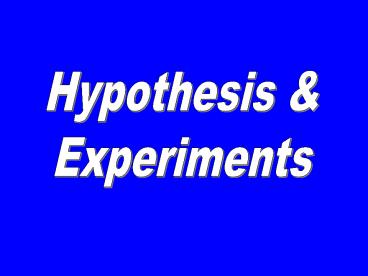Hypothesis - PowerPoint PPT Presentation
Title:
Hypothesis
Description:
the 'no difference' = null hypothesis. Delimiting the Research ... For our hypothesis concerning test strategies, we took a sample of software ... – PowerPoint PPT presentation
Number of Views:930
Avg rating:3.0/5.0
Title: Hypothesis
1
Hypothesis Experiments
2
Setting of the Problem
Statement of the Problem
Goal
Establishes
Additional information to comprehend fully the
meaning of the problem
hypothesis
scope
definitions
assumptions
3
Hypotheses
- Tentative proposition
- formulated for empirical testing
- Means for guiding and directing
- kinds of data to be collected
- analysis and interpretation
- have nothing to do with proof
- acceptance or rejection is dependant on data
4
Rejecting the Hypothesis
- Often researchers set out to disprove an
opposite/competing hypothesis - Example We believe that test strategy A uncovers
more faults than test strategy B. So our
hypothesis will be that - Programmers using test strategy A will uncover
more faults than programmers using test strategy
B for the same program.
5
Rejecting the Hypothesis
- However, we cannot actually prove this
hypothesis, we instead will try to disprove an
opposite hypothesis - There will be no difference in the fault
detection rate of programmers using test strategy
A and those using test strategy B for the same
program.
6
Rejecting the Hypothesis
- If there is a significant difference in the fault
detection rate we can reject the no difference
and by default, support our research hypothesis - the no difference null hypothesis
7
Delimiting the Research
- This is what the researcher does not want to do
in the project - Should be stated clearly and explicitly.
- What will be done is part of the problem
statement.
8
Experiments
- Studies involving the intervention by the
researcher beyond that required for measurement - usually, manipulate some variable in a setting
and observe how it affects the subject (cause and
effect) - there is at least one independent variable and
one dependent variable
9
Independent Variable
- Variable the researcher manipulates
- For our hypothesis concerning test strategies, we
took a sample of software engineers and randomly
assigned each to one of two groups one using
test strategy A and the other test strategy B.
Later we compared the fault detection rate in the
two groups.
10
Independent Variable
- We are manipulating the test strategy, thus it is
the independent variable
11
Dependent Variable
- Variable that is potentially influenced by the
independent variable - in our last example, the dependent variable is
fault detection rate - Presumably the fault detection rate is influenced
by test strategy applied - there can be more than one dependent variable
12
Conducting an Experiment
- Seven activities
- select relevant variable
- specify the level(s) of treatment
- control the experimental environment
- choose the experimental design
- select and assign the subjects
- pilot-test, revise, and test
- analyze the data
13
Select the Relevant Variables
- Translate our problem into the hypothesis that
best states the objectives of the research - how concepts are transformed into variables to
make them measurable and subject to testing - research question
- Does a product presentation that describes
product benefits in the introduction lead to
improved retention of the product knowledge?
14
The Speculation
- Product presentations in which the benefits
module is placed in the introduction of a 12
minute message produce better retention of
product knowledge that those where the benefits
module is placed in the conclusion.
15
Researchers Challenge
- Select variables that are the best operational
representations of the original concepts. - Sales presentation, product benefits retention,
product knowledge, better - Determine how many variables to test
- constrained by budget, the time allocated, the
availability of appropriate controls, and the
number of subjects. ( For statistical reasons,
there must be more subjects than variables)
16
Researchers Challenge
- select or design appropriate measures for them
- thorough review of the available literature and
instruments. - Adapted to unique needs of the research situation
17
Choosing an Experimental Design
- Experimental designs are unique to the
experimental method - statistical plans to designate relationships
between experimental treatments and the
experimenters observations - improve the probability that the observed change
in the dependent variable was caused by the
manipulation of the independent variable
18
Example of Experimental Designs
- Data-centric
- Previous discussion also applies to experimental
designs based on pre-existing data. - Data divided into evaluation and test set (also
cross-validation) - Example a look at one of my papers
19
Validity in Measurements
- Validity the extend to which instrument measures
what is supposed to be measured - E.g., thermometer ? temperature
- E.g., IQ Test ? Intelligence?
- E.g., CPU time ? algorithm complexity or
efficiency
20
Reliability of Measurement
- Reliability accuracy and consistency by which
the instrument can perform measurement - Accuracy exists only if there is consistency (not
necessarily the other way around) - Need to measure more than once
- Reliability is a necessary but not sufficient
condition for validity

